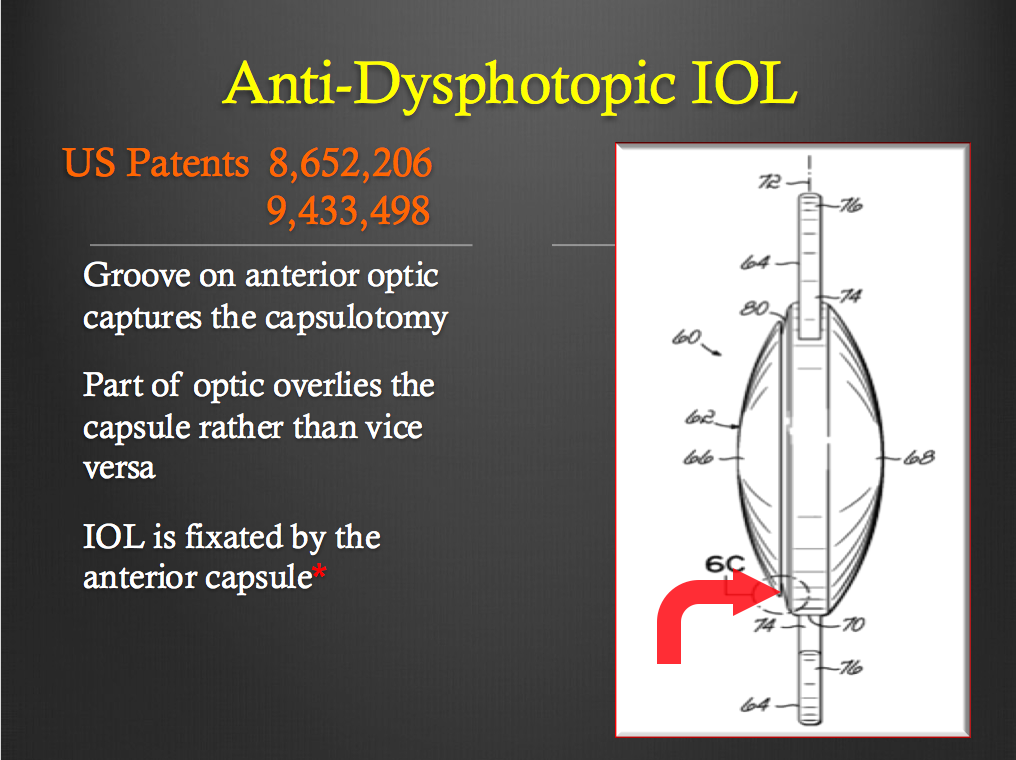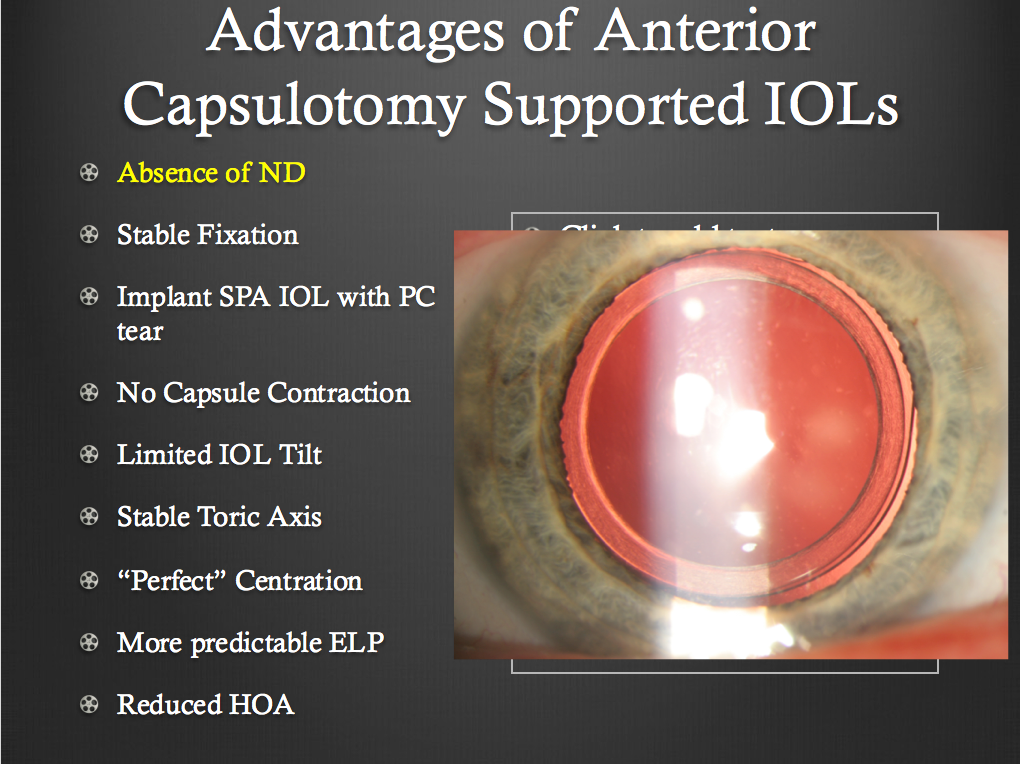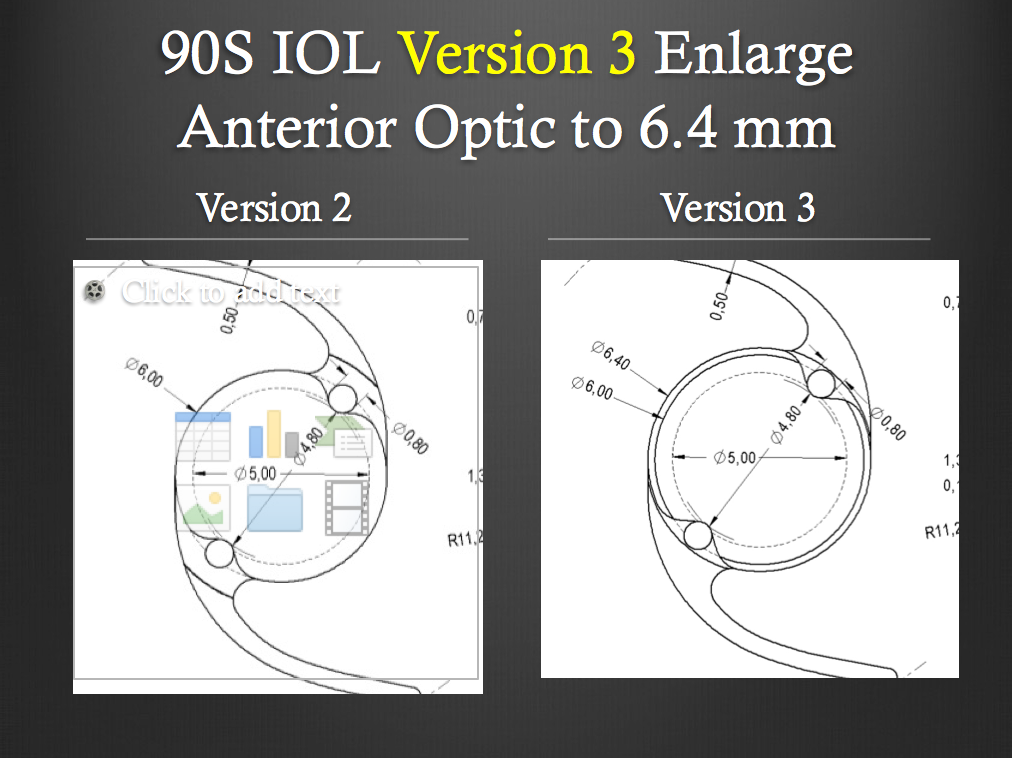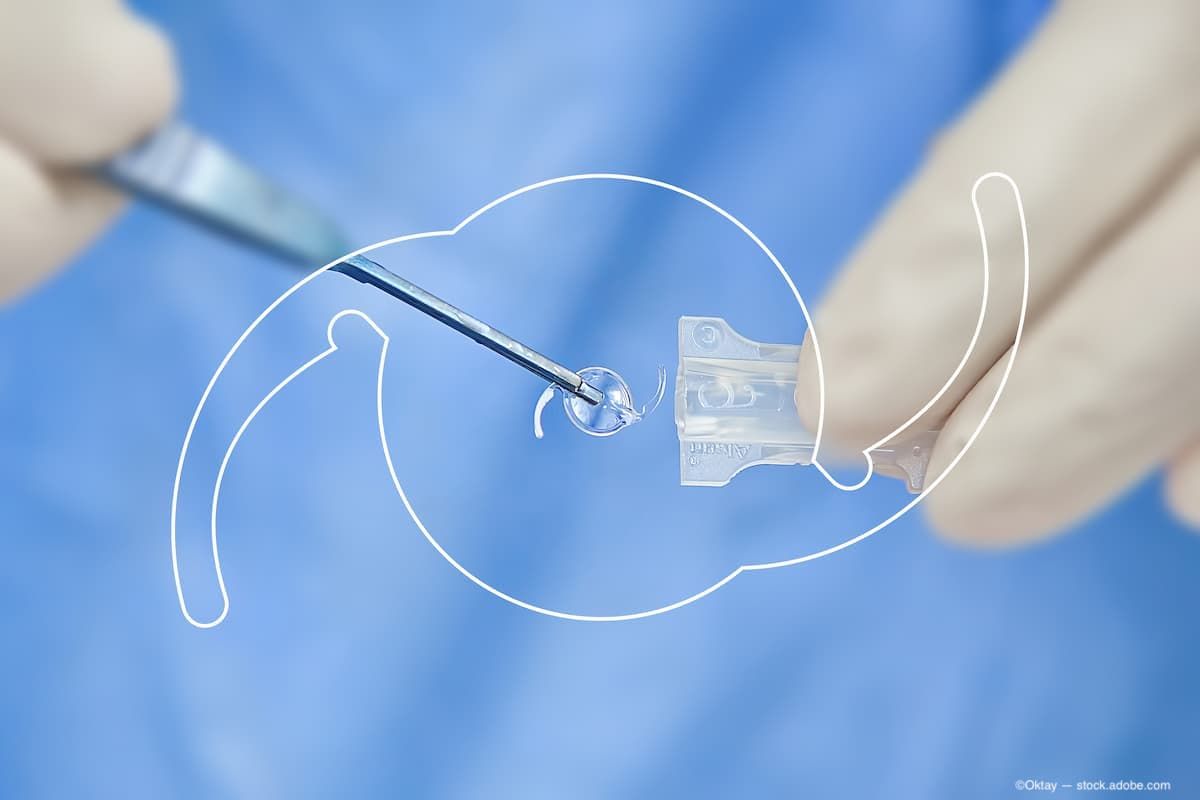Article
Novel IOL may be key to preventing negative dysphotopsia
Author(s):
By Cheryl Guttman Krader; Reviewed by Sam Masket, MD
An in-the-bag intraocular lens (IOL) with an optic that is fixated by the anterior capsule appears to be achieving its goal of preventing negative dysphotopsia. The modifications to the original design also show promise for eliminating problems of capsule block and iris-optic capture.
The optic features a groove on its anterior surface that allows for a lip of the optic to override the anterior capsulotomy (See Figure 1). Version 2 of the IOL incorporated fenestrations that were included to both prevent capsule block, allowing a route for fluid to escape from the capsular bag and to provide fixation holes that would enable surgeons to easily capture the optic in the capsulotomy.

Figure 1: Drawing from the U.S. Patent demonstrates the optic design with groove on anterior edge of optic/edge junction. Groove receives the anterior capsulotomy, establishing fixation of the IOL. (Images courtesy of Sam Masket, MD)
The third version retains the fenestrations and features a larger, 6.4-mm optic as an attempt to avoid iris-optic capture.
Samuel Masket, MD, reported that 100 eyes undergoing routine cataract surgery were implanted with the anti-dysphotopic IOL. The series includes 39 eyes implanted with version 1, 49 eyes receiving version 2, and 13 eyes implanted with version 3.
None of the eyes receiving the IOL as a primary implant develop negative dysphotopsia, and the problem resolved in 2 eyes that received the novel IOL in an exchange procedure. Among the 13 eyes implanted with version 3, there have been no cases of capsule block or iris/optic capture.
“We believe we have adequate proof-of-the-design concept for avoiding negative dysphotopsia,” said Dr. Masket, private practice, Advanced Vision Care, Los Angeles; clinical professor of ophthalmology, David Geffen School of Medicine, University of California, Los Angeles.
“We have also established an A constant, and our current plan is to implant another 30 to 50 eyes with the third model,” Dr. Masket said. “If we do not encounter problems, we will release the lens for general use in Europe.”
Clinical experience
Dr. Masket has been working with Nicole R. Fram, MD, in studying negative dysphotopsia. He noted that their clinical experience and the bulk of literature reports support the conclusion that this particular visual phenomenon, which involves perception of a dark temporal crescent, can develop with any IOL implanted in the capsular bag with the anterior capsulotomy overlying the optic edge.
The etiology is mediated, in part by the presence of an interface between the front surface of the IOL and the anterior capsulotomy. IOL material does not appear to be a risk factor.
“In a study that is in press, we reviewed 40 eyes that underwent secondary surgery for management of chronic negative dysphotopsia,” Dr. Masket said. “We found that about 75% of the eyes had an acrylic IOL and the remaining eyes had a silicone lens. That distribution roughly matches the market shares of implanted IOLs.”
Rationale
Dr. Masket’s idea for designing an optic to permit anterior capsule fixation of the lens was based on experience showing that negative dysphotopsia does not occur or can be resolved when the IOL optic edge overlies the anterior capsulotomy, such as with sulcus placement or with reverse optic capture.
Although reverse optic capture and sulcus placement seem to prevent negative dysphotopsia, those techniques have other drawbacks that make them suboptimal for primary IOL implantation, Dr. Masket said.

Figure 2: List of advantages for the capsulotomy fixated IOLs on the left and postoperative clinical photo of version 1 of Morcher 90S (Masket) IOL.
“Reverse optic capture is associated with rapid development of posterior capsule opacification because the bulk of the IOL is not in the bag,” Dr. Masket explained. “With sulcus placement there are risks for long-term decentration and iris chafing. My concept for capturing the anterior capsulotomy with the anti-dysphotopic IOL mimics reverse optic capture but with in-the-bag implantation.
Dr. Masket added that the capsulotomy-fixated design offers advantages beyond absence of negative dysphotopsia.
“This arrangement avoids IOL rotation, making it ideal for toric IOLs, prevents capsule contraction, and greatly reduces tilt and decentration,” he pointed out. “Furthermore, if the capsulotomy is centered on the visual axis, there is no induction of higher order aberrations, which is very beneficial for multifocal IOLs.”
Evolving design
Morcher licensed Dr. Masket’s anti-dysphotopic IOL design, and the lens received the CE mark for the first version of the lens (Morcher 90S) in 2014. Five surgeons implanted the 90S lens in 39 eyes.
Within the series, not 1 eye exhibited negative dysphotopsia, 3 developed capsule block, and 2 developed iris-optic capture where the iris became caught in the margin of the optic groove.
Among the 48 eyes implanted with the second version of the lens that incorporated fenestration, there were no cases of negative dysphotopsia or capsule block, but optic capture occurred in 5 eyes.

Figure 3: Version 2 and 3 of Morcher 90S (Masket) IOL. Version 3 on right features an enlarged diameter (6.4 mm) of the anterior portion of the optic.
“Of the 7 cases that developed optic capture with the first 2 versions of the IOL, 5 required reoperation, and 2 requested explantation,” Dr. Masket said.
To address the problem of iris-optic capture, Dr. Masket considered the potential causes and determined that the primary culprit was the thickness of the hydrophilic optic.
“We have not seen iris capture in any eyes where we performed reverse optic capture for implantation of a thin hydrophobic lens,” Dr. Masket said. “When we considered potential cures, we increased the diameter of the anterior part of the optic, reducing the opportunity for the pupil margin to reach the optic edge. In addition, we added carbachol to the intraoperative protocol to constrict the pupil for the first few days after surgery.”
Dr. Masket also believes that meticulous wound management is important for preventing iris-optic capture considering that wound leak leading to anterior chamber shallowing may play a role.
Samuel Masket, MD
This article is based on presentations delivered by Dr. Masket at the 2018 Cataract Surgery: Telling It Like It Is meeting and the 2017 American Academy of Ophthalmology meeting. Dr. Masket holds U.S. patents on the IOL design and has a licensing agreement with Morcher.
Newsletter
Don’t miss out—get Ophthalmology Times updates on the latest clinical advancements and expert interviews, straight to your inbox.





